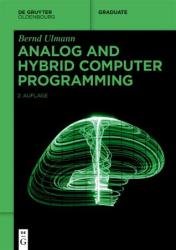 Название: Analog and Hybrid Computer Programming, 2nd Edition
Название: Analog and Hybrid Computer Programming, 2nd EditionАвтор: Bernd Ulmann
Издательство: De Gruyter
Год: 2023
Страниц: 316
Язык: английский
Формат: pdf (true)
Размер: 35.2 MB
As classic digital computers are about to reach their physical and architectural boundaries, interest in unconventional approaches to computing, such as quantum and analog computers, is rapidly increasing. For a wide variety of practical applications, analog computers can outperform classic digital computers in terms of both raw computational speed and energy efficiency. This makes them ideally suited a co-processors to digital computers, thus forming hybrid computers. This second edition of "Analog and Hybrid Computer Programming" provides a thorough introduction to the programming of analog and hybrid computers. It contains a wealth of practical examples, ranging from simple problems such as radioactive decay, harmonic oscillators, and chemical reaction kinetics to advanced topics which include the simulation of neurons, chaotic systems such as a double-pendulum simulation and many more. In addition to these examples, it contains a chapter on special functions which can be used as "subroutines" in an analog computer setup.
A book about programming analog and hybrid computers may seem like an anachronism in the 21st century – why should one be written and, even more important, why should you read it? As much as analog computers seem to have been forgotten, they not only have an interesting and illustrious past but also an exciting and promising future in many application areas, such as high performance computing (HPC for short), the field of dynamic systems simulation, education and research, artificial intelligence (biological brains operate, in fact, much like analog computers), and, last but not least, as coprocessors for traditional stored-program digital computers, thereby forming hybrid computers.
From today’s perspective, analog computers are mainly thought of as being museum pieces and their programming paradigm seems archaic at first glance. This impression is as wrong as can be and is mostly caused by the classic patch field or patch panel onto which programs are patched in form of an intricate maze of wires, resembling real spaghetti “code”... On reflection, this form of programming is much easier and more intuitive than the algorithmic approach used for stored-program digital computers (which will be just called digital computers from now on to simplify things). Future implementations of analog computers, especially those intended as coprocessors, will probably feature electronic cross-bar switches instead of a patch field. Programming such machines will resemble the programming of a field programmable gate array (FPGA), i. e., a compiler will transform a set of problem equations into a suitable setup of the crossbar-switches, thus configuring the analog computer for the problem to be solved.
Although analog computers are extremely powerful on their own, the combination of an analog computer and a digital computer forming a hybrid computer is even more powerful. This idea is by no means new – as early as 1956 Space Technology Laboratories developed the ADDAVERTER, a system capable of coupling an analog computer with a digital computer by using up to 15 ADCs and DACs, each featuring a resolution of ±0.1 %. The rationale behind such a setup is that digital computers are good in areas where analog computer have deficiencies and vice versa. Applications for such hybrid computer setups are abundant due to their computational power and energy efficiency. The following examples and explanations are based on the hybrid controller for the Analog Paradigm Model-1 analog computer, but the ideas and techniques presented are by not restricted to this particular setup. Similar coupling devices have been available in the past and can be built using cheap off-the-shelf hardware such as Arduino-boards, etc.
Training an AI with an analog computer: The following example is more demanding with respect to the interplay between the digital and analog computers, which must work in parallel. The analog computer simulates an inverted pendulum, as described in section 6.33, while the digital computer implements a Reinforcement Learning algorithm that learns to keep the inverted pendulum in its upright vertical position by actively balancing it. The reinforcement learning system has been implemented in Python 3.
Скачать Analog and Hybrid Computer Programming, 2nd Edition